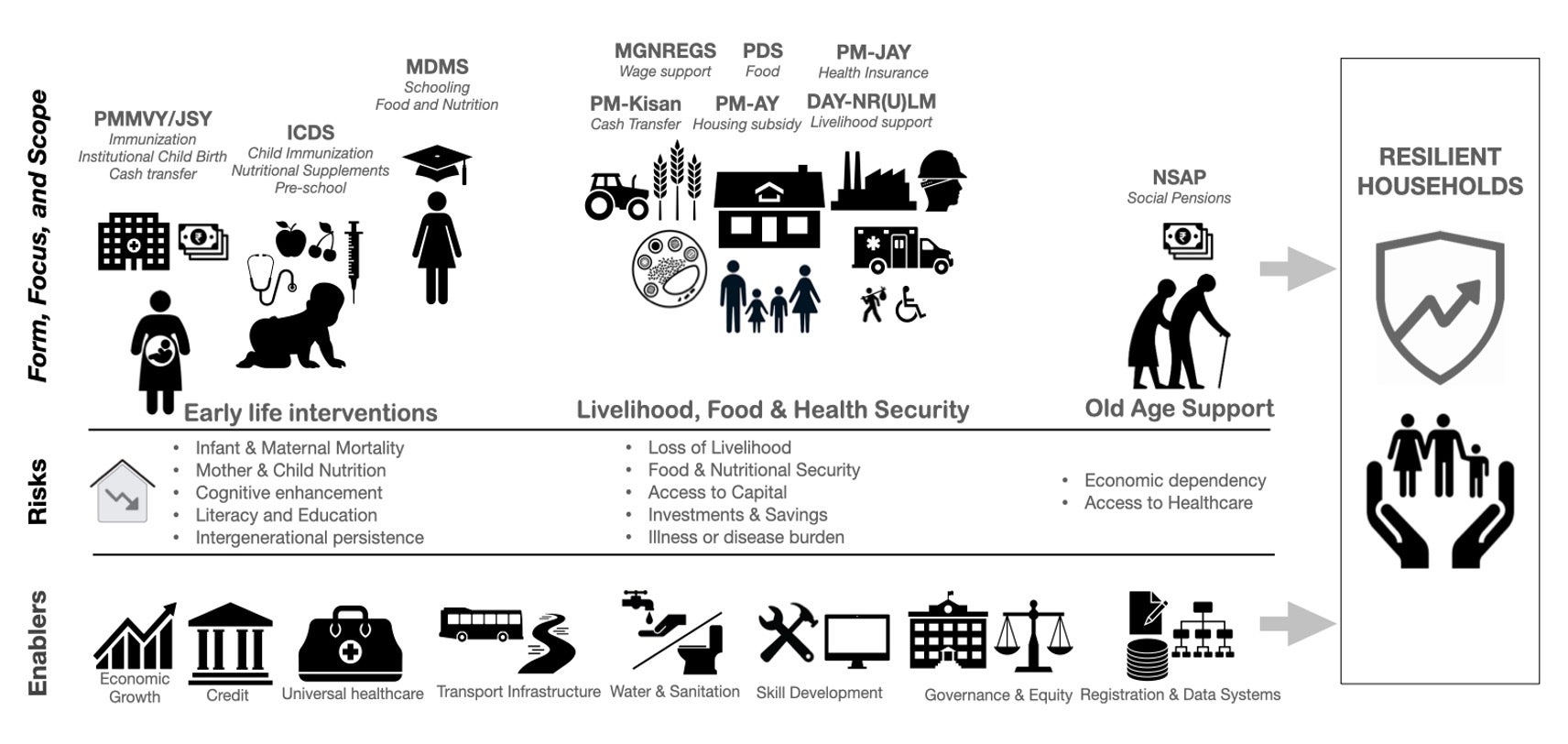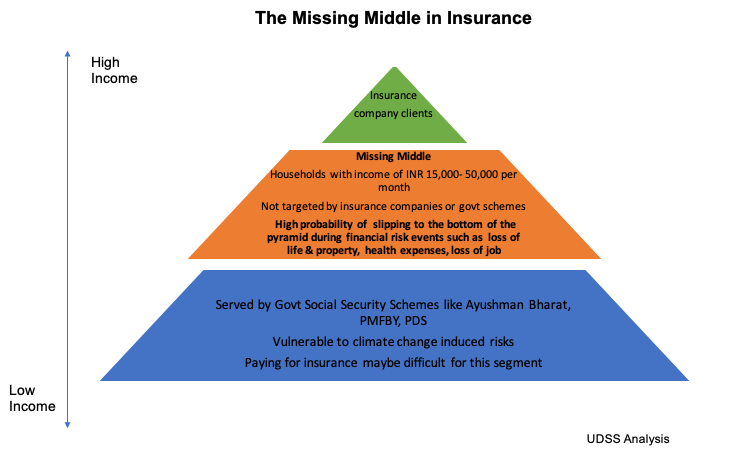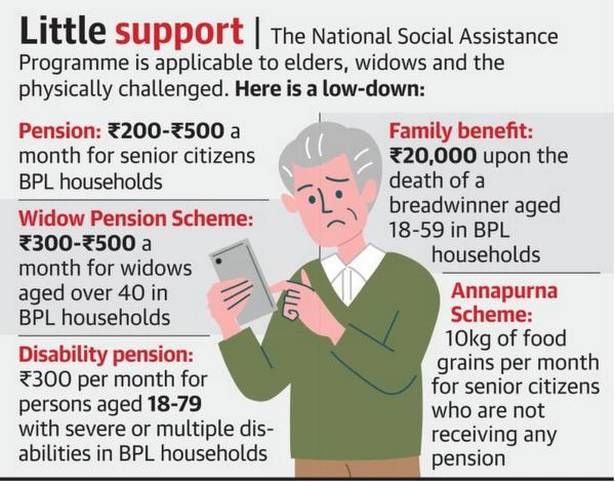Introduction
As societies age, the role of state and public policies becomes increasingly central in safeguarding the well-being of older adults. The shift in demographics, characterized by longer life expectancies and declining fertility rates, has intensified the demand for sustainable frameworks that address financial security, health care, and social integration in old age. Public policies such as social assistance, social insurance, pension schemes, and health care support represent essential mechanisms through which governments respond to the challenges of aging.
Read More: Geropsychology
1. Social Assistance
Social assistance refers to non-contributory, need-based programs designed to provide financial or material support to older adults who lack sufficient resources. It functions as a safety net, ensuring that individuals without pensions, savings, or family support are not left destitute (Schulz, 2006).

Social Welfare in India
Advantages
Social assistance directly addresses poverty in later life, reducing inequality and preventing neglect of vulnerable populations. By offering cash transfers, food subsidies, or housing assistance, such programs fulfill immediate survival needs while promoting social justice. Feldman and Babu (2011) emphasize that in societies with weak family caregiving structures, social assistance becomes indispensable.
Challenges
However, social assistance has limitations. It is often stigmatized, perceived as “charity” rather than entitlement, which can affect self-esteem and dignity (Eyetsemitan & Gire, 2003). Inadequate funding and bureaucratic inefficiencies also limit effectiveness, especially in developing contexts. Moreover, Taylor (1999) highlights that financial insecurity is closely linked to mental health outcomes; poorly managed assistance systems can perpetuate anxiety, depression, and social exclusion among the elderly.
2. Social Insurance
Unlike social assistance, social insurance is contributory. Workers and employers contribute during employment, and benefits are disbursed during retirement or disability. It includes pensions, health insurance, and unemployment benefits, offering more predictable and structured support (Schulz, 2006).

Problem of Insurance in India
Advantages
Social insurance fosters a sense of entitlement and dignity, as benefits are tied to prior contributions. This reduces the stigma associated with assistance and enhances self-worth in older adults (Birren & Schaie, 2001). Furthermore, it provides economic stability by replacing lost income, which is crucial for maintaining quality of life.
Challenges
The sustainability of social insurance is under strain due to demographic shifts. Longer lifespans and shrinking workforces place pressure on pension and health insurance systems. Eyetsemitan and Gire (2003) argue that in many developing countries, where informal labor predominates, large segments of the population are excluded from contributory schemes. Hence, social insurance often benefits only those in formal employment, leaving others vulnerable.
3. Pension Systems
Pensions form the cornerstone of financial security in old age. They provide periodic payments to retirees, either through contributory (earnings-based) or non-contributory schemes. Pensions not only address material needs but also contribute to psychological security by reducing uncertainty about the future (Hurlock, 1981).

Issue of Pension System in India
Advantages
Well-structured pension systems offer stability, reducing dependence on family or charity. This independence preserves dignity and autonomy, essential components of well-being in late adulthood (Feldman & Babu, 2011). In Western contexts, pensions often enable active aging by supporting leisure, travel, and lifelong learning.
Challenges
Inadequate pensions remain a challenge in both developed and developing countries. Inflation, rising medical costs, and longer lifespans erode pension adequacy (Schulz, 2006). Moreover, gender disparities in labor markets lead to lower pensions for women, exacerbating vulnerability in old age (Johnson & Walker, 2016).
4. Health and Medical Care Support
Access to affordable, quality health care is perhaps the most critical component of aging policy. Health care support for the elderly includes preventive care, treatment of chronic illnesses, rehabilitation, and long-term care services.
Advantages
Effective health care policies reduce morbidity, improve quality of life, and extend healthy life expectancy. Taylor (1999) emphasizes that health care not only addresses physical needs but also reduces psychological distress by alleviating uncertainty about illness and mortality. Moreover, health services that integrate preventive measures encourage active aging and reduce the burden of disease.
Challenges
Despite its importance, health care support faces several obstacles. Rising costs of medical care, shortages of geriatric specialists, and inequities in access remain pressing issues (Schulz, 2006). In developing countries, health systems are often underfunded and ill-equipped to manage the complex needs of older populations (Eyetsemitan & Gire, 2003). Additionally, fragmented care systems may fail to address the holistic needs of older adults, neglecting the psychological and spiritual dimensions of aging (Johnson & Walker, 2016).
Psychological Implications of Public Policy
Public policies affect not only material conditions but also psychological outcomes. Financial security through pensions or insurance reduces stress, enabling older adults to focus on meaningful pursuits and maintain self-esteem (Hurlock, 1981). Conversely, inadequate or unreliable support can foster anxiety, helplessness, and social withdrawal (Comer, 2007).
Furthermore, access to health care enhances psychological well-being by ensuring that physical ailments do not become overwhelming sources of distress. Johnson and Walker (2016) emphasize that spiritual and existential needs must also be incorporated into health systems to support holistic well-being.
Cross-Cultural Perspectives
The effectiveness and perception of public policies vary across cultures. In Western societies, pensions and insurance are normalized, with older adults expecting state support as a right. In contrast, in many developing contexts, reliance on state systems is limited, and family-based care remains central (Eyetsemitan & Gire, 2003). However, urbanization and modernization are weakening traditional family support systems, making state policies increasingly critical.
Birren and Schaie (2001) note that continuity theory suggests older adults thrive when policies enable them to maintain established roles and routines. Thus, systems must adapt not only to economic and health needs but also to cultural values and expectations.
Future Directions
As aging populations expand, state and public policies face mounting challenges. Future strategies should focus on:
- Integrating Assistance and Insurance: Hybrid systems that combine universal basic support with contributory schemes can ensure equity while maintaining sustainability.
- Pension Reform: Indexing pensions to inflation, addressing gender disparities, and expanding coverage to informal workers are critical steps.
- Strengthening Health Care: Expanding geriatric care, integrating mental health and spiritual support, and utilizing telemedicine can enhance access and quality.
- Technology Integration: Digital platforms for accessing benefits and monitoring health can increase efficiency and reduce exclusion.
- Global Cooperation: Sharing best practices across countries can strengthen systems, particularly in developing contexts with limited resources.
Conclusion
State and public policies play a foundational role in shaping the experience of aging. Social assistance ensures that no older adult is left destitute, while social insurance and pension systems provide stability and dignity. Health and medical care support addresses physical, psychological, and existential dimensions of aging. Together, these policies not only secure survival but also enhance the quality of life, autonomy, and social integration of older adults.
Yet challenges remain: demographic shifts, financial sustainability, gender inequalities, and health care inequities. To meet these challenges, policies must evolve toward inclusivity, sustainability, and holistic care. By integrating financial, medical, psychological, and cultural perspectives, societies can ensure that aging is not merely an extension of years but an opportunity for continued growth, fulfillment, and dignity.
References
Birren, J. E., & Schaie, K. W. (2001). Handbook of the psychology of aging (5th ed.). Academic Press.
Comer, R. J. (2007). Abnormal psychology (6th ed.). Worth Publishers.
Eyetsemitan, F. E., & Gire, J. T. (2003). Aging and adult development in the developing world: Applying Western theories and concepts. Library of Congress.
Feldman, R. S., & Babu, N. (2011). Discovering the life span. Pearson.
Hurlock, E. B. (1981). Developmental psychology: A life-span approach (5th ed.). Tata McGraw-Hill.
Johnson, M., & Walker, J. (2016). Spiritual dimensions of aging. Cambridge University Press.
Schulz, R. (2006). The encyclopaedia of aging: A comprehensive resource in gerontology and geriatrics (4th ed.). Springer Publishing.
Taylor, S. E. (1999). Health psychology (4th ed.). McGraw-Hill.
Niwlikar, B. A. (2025, September 11). State and Public Policies: 4 Important Considerations. Careershodh. https://www.careershodh.com/state-and-public-policies/
